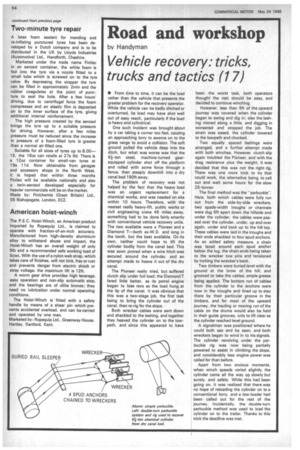Road and workshop
Page 56

If you've noticed an error in this article please click here to report it so we can fix it.
by Handyman
Vehicle recovery: tricks, trucks and tactics (17)
• From time to time, it can be the load rather than the vehicle that presents the greater problem for the recovery operator. While the vehicle can be badly ditched or overturned, its load may have shot well out of easy reach, particularly if the load is heavy and cylindrical.
One such incident was brought about by a car taking a corner too fast, causing an approaching lorry to swerve on to the grass verge to avoid a collision. The soft ground pulled the vehicle deep into the ditch, but what was worse was that the 6i-ton steel, machine-turned gearequipped cylinder shot off the platform and rolled with some force through a fence, then steeply downhill into a dry canal bed 1 90ft away.
The problem of recovery was not helped by the fact that the heavy load was an urgent replacement for a chemical works, and was needed on site within 10 hours. Therefore, with the nearest really heavy-lift, public works or civil engineering crane 46 miles away, something had to be done fairly smartly with conventional vehicle recovery units. The two available were a Pioneer and a Diamond T—both ex-W.D. and long in the tooth, but the best available. On its own, neither could hope to lift the cylinder bodily from the canal bed. This was soon proved when a wire hitch was secured around the cylinder, and an attempt made to heave it out of the dry canal.
The Pioneer really tried, but suffered clutch slip under full load; the Diamond T fared little better, as its petrol engine began to lose revs as the load hung at the lip of the canal. It was obvious that this was a two-stage job, the first task being to bring the cylinder out of the canal, then re-rig for the slope.
Both wrecker cables were sent down and shackled to the lashing, and together they heaved the cylinder on to the towpath, and since this appeared to have been the worst task, both operators thought the rest should be easy, and decided to continue winching.
However, less than 5ft of the upward journey was covered when the cylinder began to swing and dig in: also the lashing moved along a little, and digging in worsened and stopped the job. The strain was eased, the cylinder lowered to the towpath and chocked.
Two equally spaced lashings were arranged, and a further attempt made with both winches. However, clutch slip again troubled the Pioneer, and with the drag resistance plus the weight. it was decided that this was not the right rig. There was one more trick to try that could work, the alternative being to call out and wait some hours for the slow 25-tonner.
The final method was the "parbuckle". Here, both winch cables were fully run out from the side-by-side wreckers, two spade-width troughs or channels were dug 6ft apart down the hillside and under the cylinder, the cables were passed over the cylinder, under, up and over again, under and back up to the hill top. These cables were laid in the troughs and their ends shackled to four spud anchors. As an added safety measure, a chain was laced around each spud anchor below the lug, the chain ends being taken to the wrecker tow pins and tensioned by inching the wrecker's back.
Two timbers were buried level with the ground at the brow of the hill, and grooved to take the cables, ample grease being applied. The bottom run of cables from the cylinder to the anchors were now in the troughs and lined up to stay there by their particular groove in the timbers, and for most of the upward journey. the hauling or moving run of the cable on the drums would also be held in their guide grooves, only to lift clear as the cylinder reached level ground.
A signalman was positioned where he could both see and be seen, and both wreckers began to wind in to his signals. The cylinder revolving under the parbuckle rig was now being partially powered to assist in climbing the slope, and considerably less engine power was called for than before.
Apart from two anxious moments, when winch speeds varied slightly, the cylinder came all the way up slowly but surely, and safely. While this had been going on, it was realized that there was no hope of reloading the cylinder on to a conventional lorry, and a low-loader had been called out for the rest of the journey. Incidentally, the double-turn parbuckle method was used to load the cylinder on to the trailer. Thanks to this trick the deadline was met.








































































































































